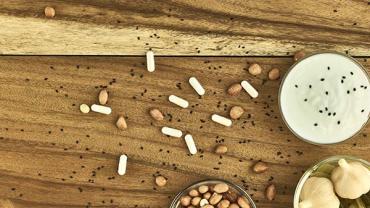
As our understanding of the foundational nature of the microbiome in directing the trajectory of our health and wellbeing continues to deepen, probiotics grow in their ranking as a vital nutraceutical, capable of steering the ship of health. However, in order for these organisms to exert their power of influence over the microbiome, they must be able to reach it, relatively unharmed, and that is not an easy feat. In fact, some studies have shown that a minimum of 108 to 109 viable probiotic cells must reach the intestine for health benefits to be achieved. Probiotics face multiple threats to their survival during processing, storage, and delivery to the human gastrointestinal tract.
Moisture is one element that threatens the survivability of probiotics and, therefore, reduces their therapeutic potential. At face value, this may seem a confusing phenomenon since probiotics in the gut are, after all, existing in an aqueous environment. Moisture and humidity do, indeed, activate probiotics, but upon activation, they quickly begin to deteriorate. Therefore, it is vital that this process happens only after the probiotics reach the microbiome and not before. Even exposure to air during processing and storage can impart enough moisture to activate probiotics, necessitating some sort of encapsulation process that will protect the microorganisms from this element before they reach the gut.
Technological advancements have continued to evolve in order to deal with the problem of moisture. Freeze-drying, including adequate overage (additional colony forming units to cover those that will be lost in storage), and selecting moisture-resistant strains help in overcoming the problem of moisture, but encapsulation technology has also become an important consideration in ensuring probiotics are protected and their viability is sustained.
Desiccant-lined bottles offer a newer technology that protects probiotics from damaging exposure to moisture, oxygen, and light to extend the shelf life of probiotics while eliminating the need for refrigeration. The interior of the bottles is lined in a specially engineered desiccant sleeve which absorbs moisture in a controlled manner. These are superior to the traditional desiccant sachets that are floating around in most bottles of supplements for the purpose of absorbing moisture. By using a sachet, the moisture often passes through the probiotics within the bottle before being absorbed by the sachet. Using a desiccant lined bottle protects probiotics from this initial exposure by creating a barrier between the incoming moisture and the probiotics.
In a comparison at UAS labs of probiotic potency over time using the Stability Shield™ desiccant lined bottle or a bottle containing a desiccant sachet, the bottle using the sachet lost all potency after almost 15 months whereas the desiccant lined bottle maintained potency greater than the specification of a minimum of 10 billion CFU after 24 months of study. A similar comparison was made at UAS labs between the Stability Shield™ desiccant lined bottles and a standard amber glass bottle, both containing a 4-strain probiotic blend, at various temperatures and humidity levels. At 4 degrees Celsius, both bottles maintained potency after 24 months. At 25 degrees Celsius, the potency began dropping in the amber glass bottle within 6 months. At 25 degrees Celsius and 60 percent relative humidity, the potency in the amber glass bottle began dropping at 3 months and was significantly reduced at 20 months. Finally, at 30 degrees Celsius and 65 percent relative humidity, the potency in the amber glass bottle began dropping before 2 months and was significantly reduced at 15 months. In all comparison studies, the desiccant lined bottle maintained potency.
Desiccant lined bottles offer cutting edge technology that has risen above all previous technological advancements in the probiotic industry to ensure the delivery of viable organisms by regulating moisture consistently from the time of packaging to the last pill left taken by the consumer. While it is vital to include stable, resistant strains and good overage, desiccant lined bottles bring a new level of assurance and convenience to consumers by maintaining therapeutic doses, and without the requirement for refrigeration.